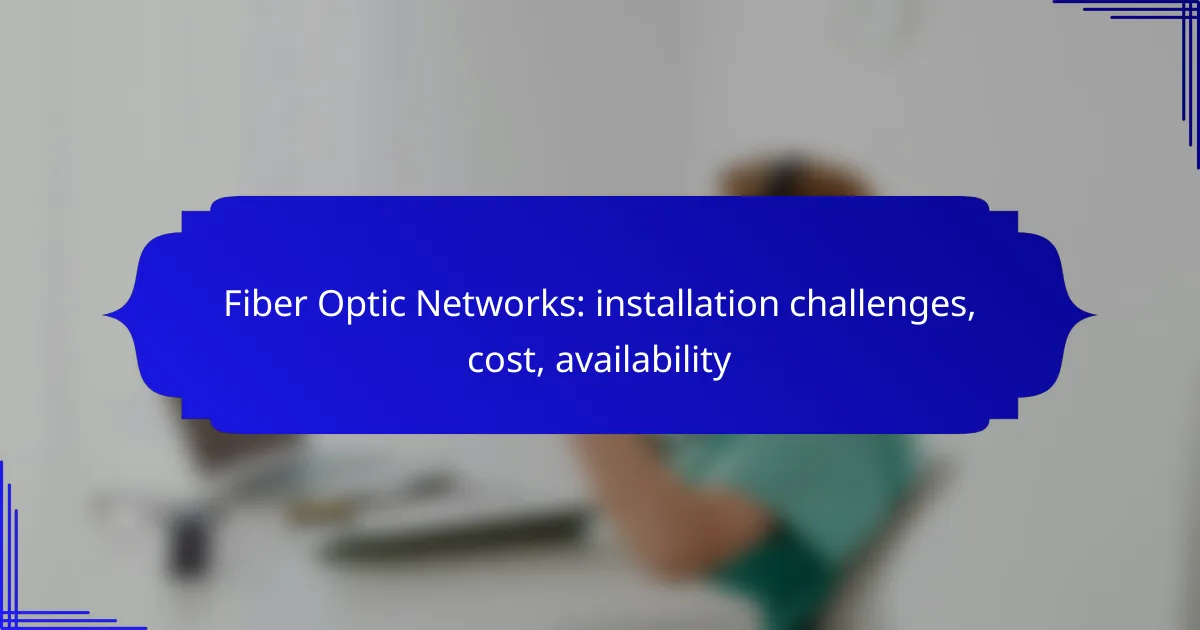Installing fiber optic networks in New Zealand involves navigating various challenges such as high costs, complex underground work, and the need for specialized labor. The expenses associated with installation can range widely based on factors like location and project scale. Additionally, while urban areas often enjoy extensive fiber coverage, many rural regions still face significant gaps in high-speed internet access.
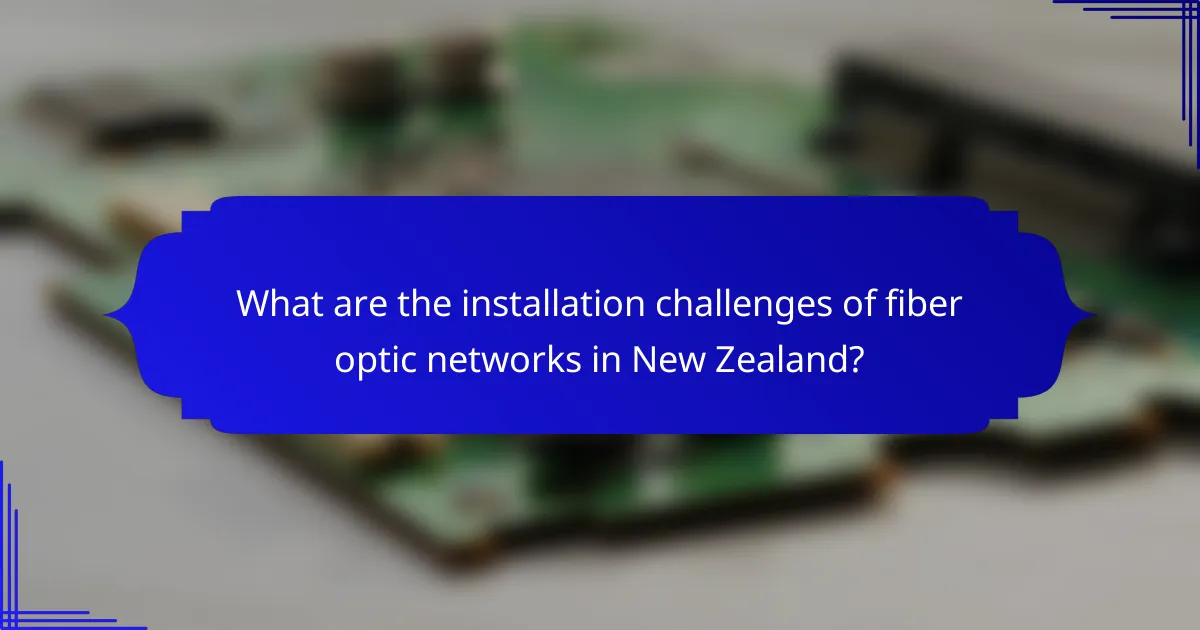
What are the installation challenges of fiber optic networks in New Zealand?
Installing fiber optic networks in New Zealand presents several challenges, including high costs, complex underground work, weather impacts, the need for specialized labor, and regulatory compliance. Addressing these challenges effectively is crucial for successful deployment and operation.
High installation costs
The installation costs of fiber optic networks can be significant, often ranging from thousands to tens of thousands of New Zealand dollars per kilometer. Factors contributing to these costs include materials, labor, and the need for specialized equipment. Budgeting for unexpected expenses is essential, as initial estimates can often fall short.
To mitigate costs, consider phased rollouts or partnerships with local governments and businesses. This approach can help share expenses and reduce the financial burden on a single entity.
Complexity of underground installations
Installing fiber optics underground involves navigating existing infrastructure, which can complicate the process. Challenges include avoiding utilities, managing soil conditions, and ensuring proper trenching techniques. Each of these factors can lead to delays and increased costs.
Planning and conducting thorough site surveys before installation can help identify potential obstacles. Engaging with local authorities early in the process can also facilitate smoother operations and reduce complications.
Weather-related delays
New Zealand’s diverse weather patterns can significantly impact fiber optic installation timelines. Heavy rain, strong winds, and other adverse conditions can halt work and delay project completion. It’s essential to account for seasonal weather variations when planning installation schedules.
Establishing flexible timelines and having contingency plans can help manage these weather-related challenges. Monitoring forecasts and preparing for potential disruptions can also minimize delays.
Need for specialized labor
Fiber optic installations require skilled technicians with specific training and experience. The shortage of qualified labor in New Zealand can lead to project delays and increased costs. Ensuring that your team is well-trained and familiar with the latest technologies is crucial for successful installations.
Consider investing in training programs or collaborating with local technical schools to develop a skilled workforce. This can help alleviate labor shortages and improve project efficiency.
Regulatory compliance issues
Fiber optic network installations must comply with various local regulations and standards, which can vary by region in New Zealand. Navigating these regulations can be complex and time-consuming, potentially delaying projects. Understanding the specific requirements for your area is essential for compliance.
Engaging with regulatory bodies early in the planning process can help ensure that all necessary permits and approvals are obtained. Staying informed about changes in regulations can also prevent compliance issues that could arise during installation.
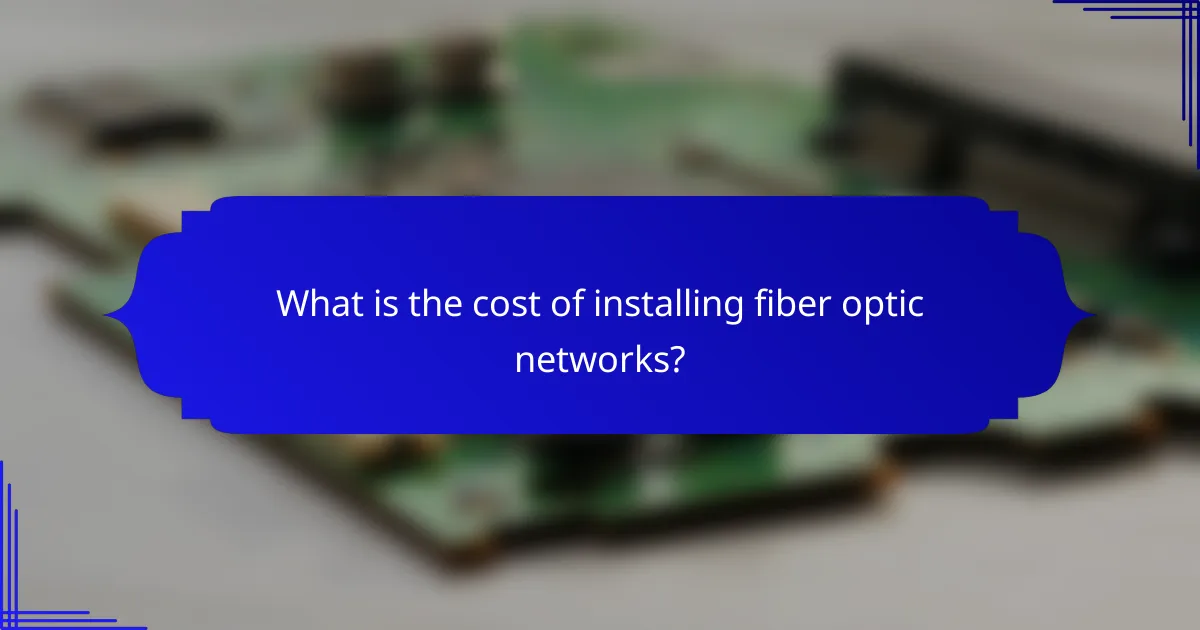
What is the cost of installing fiber optic networks?
The cost of installing fiber optic networks can vary significantly based on multiple factors, including location, project scale, and specific installation requirements. Generally, expenses can range from several thousand to tens of thousands of dollars per kilometer, depending on these variables.
Average cost per kilometer
The average cost for installing fiber optic networks typically falls between $20,000 and $50,000 per kilometer. This range can fluctuate based on urban versus rural settings, with urban installations often being more expensive due to higher labor costs and regulatory requirements.
In some cases, costs may be lower in areas with existing infrastructure that can be leveraged, such as utility poles or conduits. Conversely, challenging terrains or densely populated areas may drive costs higher.
Factors influencing installation costs
Labor costs are another significant consideration, as skilled technicians are required for installation and splicing. Additionally, geographical challenges, such as rocky soil or water bodies, can increase expenses due to the need for specialized equipment or techniques.
Cost comparison with copper networks
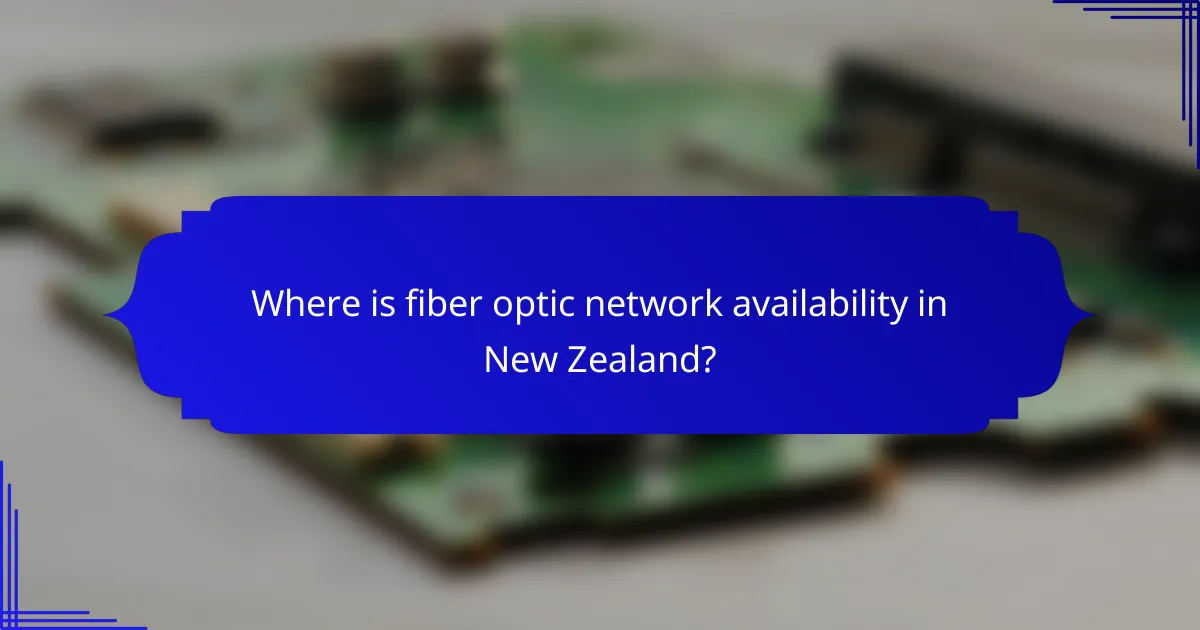
Where is fiber optic network availability in New Zealand?
Fiber optic network availability in New Zealand varies significantly between urban and rural areas. Major cities tend to have extensive coverage, while many rural regions still lack access to high-speed fiber services.
Major cities with fiber optic coverage
In New Zealand, cities like Auckland, Wellington, and Christchurch boast comprehensive fiber optic coverage. These urban centers have invested heavily in infrastructure, allowing residents and businesses to access high-speed internet services with speeds often exceeding 1 Gbps.
Additionally, cities such as Hamilton and Tauranga are also expanding their fiber networks, making it easier for more residents to connect to reliable, high-speed internet. The rollout in these areas is typically supported by local government initiatives and private investments.
Rural areas lacking fiber optic access
Many rural areas in New Zealand still face challenges in accessing fiber optic networks. Regions such as parts of the South Island and remote areas in the North Island often rely on slower alternatives like DSL or satellite internet.
The lack of infrastructure investment in these areas means that residents may experience significantly lower internet speeds and reliability compared to urban counterparts. Efforts are ongoing to improve connectivity, but progress can be slow due to geographical and financial constraints.
Providers offering fiber optic services
Several major providers offer fiber optic services in New Zealand, including Spark, Vodafone, and 2degrees. These companies provide various plans tailored to different needs, from basic home internet to high-speed business solutions.
When selecting a provider, consider factors such as contract length, installation fees, and customer service. Comparing offerings can help ensure you choose the best plan for your specific location and usage requirements.
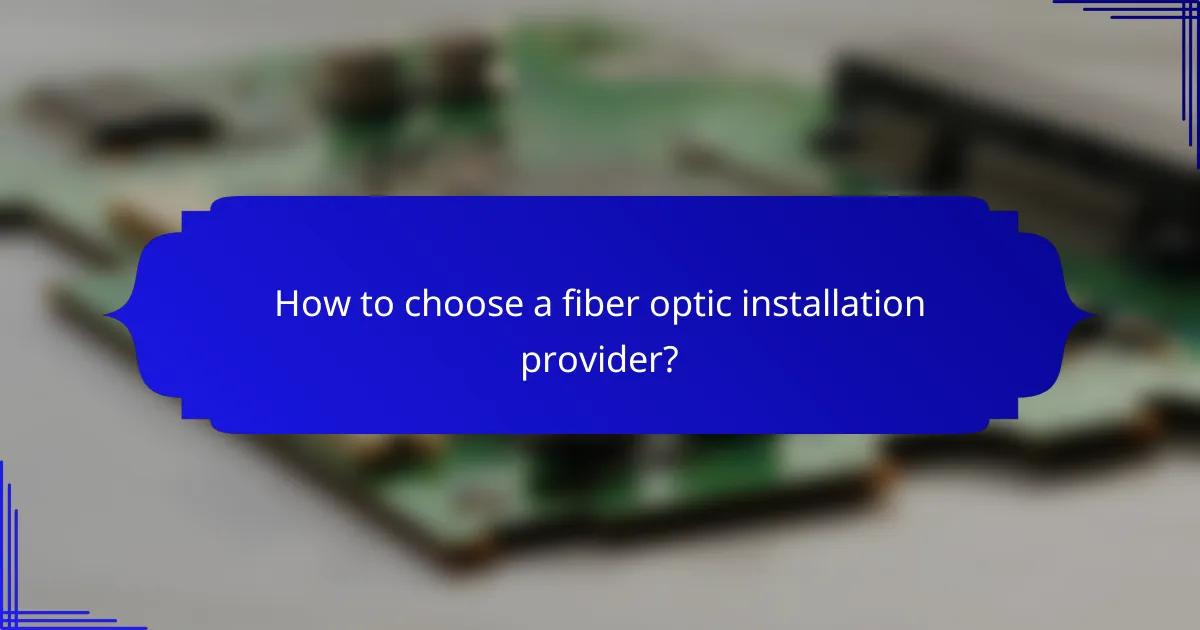
How to choose a fiber optic installation provider?
Selecting a fiber optic installation provider involves evaluating their experience, service offerings, and customer feedback. Focus on providers that demonstrate technical expertise, reliability, and a strong track record in your area.
Key selection criteria
When choosing a fiber optic installation provider, consider their industry experience and certifications. Look for companies that have completed similar projects and have positive reviews from previous clients.
Assess the range of services offered, including installation, maintenance, and support. A provider that offers comprehensive services can save you time and effort in managing multiple contractors.
Pricing transparency is crucial. Request detailed quotes and compare them against the services provided to ensure you are getting value for your investment.
Top providers in New Zealand
In New Zealand, several reputable fiber optic installation providers stand out. Companies like Chorus and Enable Networks are known for their extensive fiber networks and reliable service.
Another notable provider is Vocus, which offers tailored solutions for both residential and commercial clients. Their experience in the market and customer-centric approach make them a strong contender.
When evaluating these providers, consider their coverage areas, service packages, and customer support options to find the best fit for your needs.
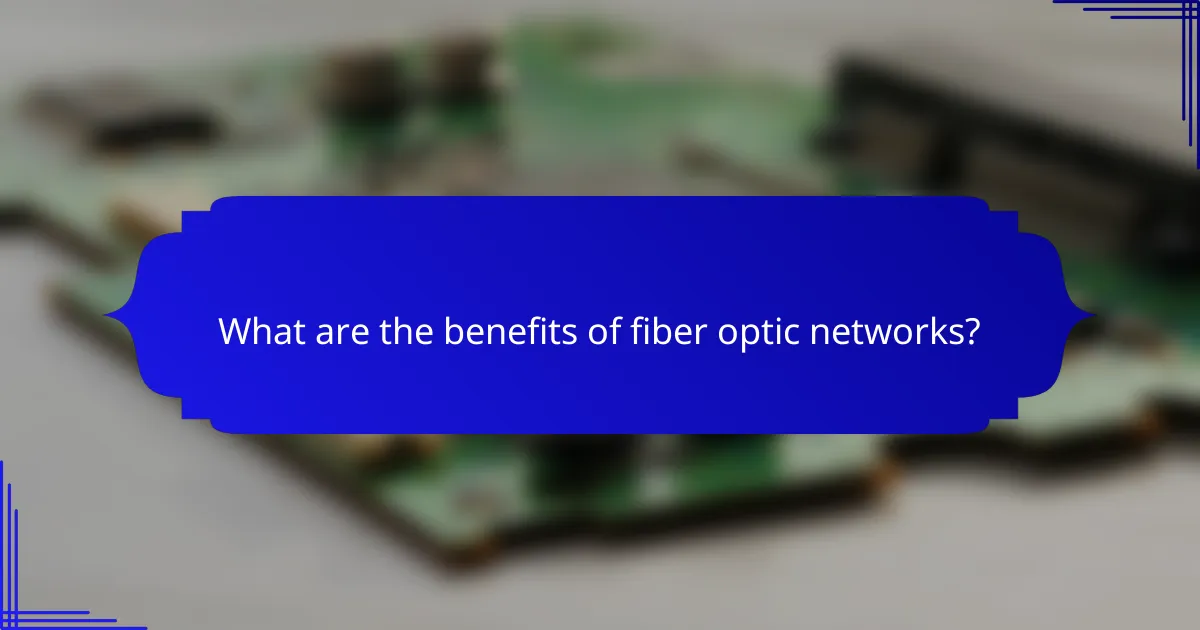
What are the benefits of fiber optic networks?
Fiber optic networks offer numerous advantages, including higher data transmission speeds, enhanced reliability, and reduced latency. These benefits make fiber optics a preferred choice for both residential and commercial internet services.
Higher bandwidth capacity
Fiber optic networks can support significantly higher bandwidth compared to traditional copper cables. This means they can handle more data simultaneously, making them ideal for high-demand applications such as streaming, gaming, and large file transfers.
For example, fiber optics can provide speeds ranging from hundreds of megabits per second (Mbps) to several gigabits per second (Gbps). This capacity allows multiple users to connect without experiencing slowdowns, which is crucial for businesses and households with many devices.
Improved reliability
Reliability is a key benefit of fiber optic networks, as they are less susceptible to interference and environmental factors than copper lines. Fiber optics are immune to electromagnetic interference, which can disrupt data transmission in traditional networks.
Additionally, fiber cables are more durable and can withstand harsh weather conditions, making them a more dependable option for both urban and rural installations. This reliability translates to fewer outages and a more stable internet connection for users.
Lower latency
Lower latency is another significant advantage of fiber optic networks, allowing for faster data transmission with minimal delay. Latency refers to the time it takes for data to travel from the source to the destination, and fiber optics can achieve latency in the low tens of milliseconds.
This reduced latency is particularly beneficial for real-time applications such as video conferencing, online gaming, and financial trading, where every millisecond counts. Users can expect a more responsive experience, enhancing overall satisfaction with their internet service.
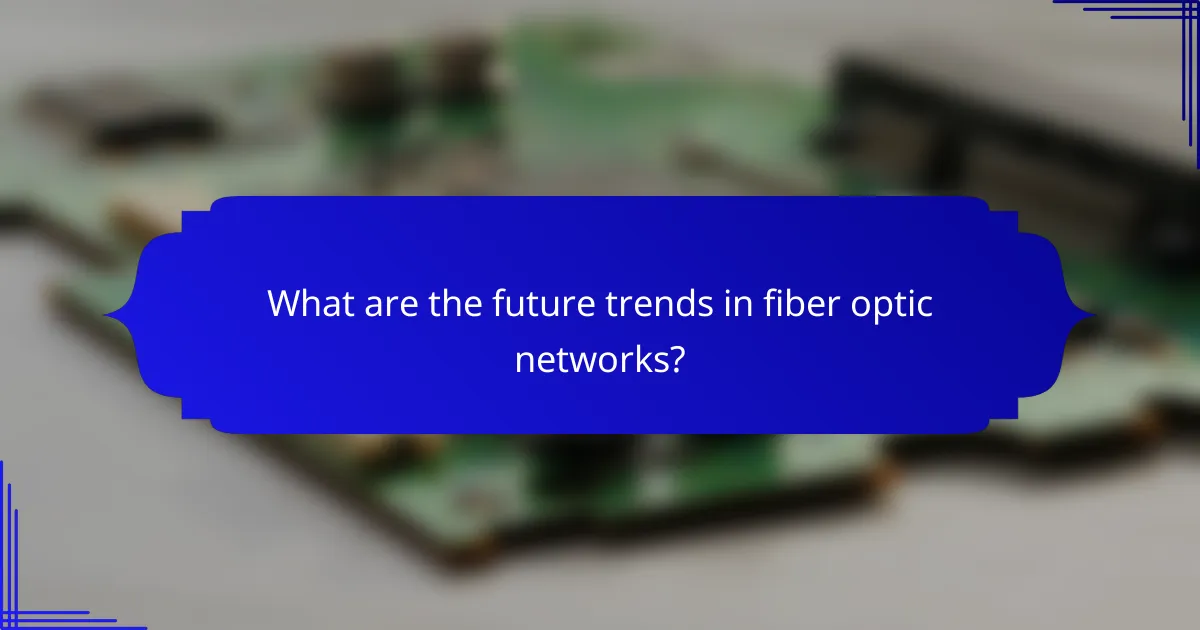
What are the future trends in fiber optic networks?
Future trends in fiber optic networks include increased adoption of 5G technology, advancements in optical fiber materials, and the expansion of fiber-to-the-home (FTTH) initiatives. These trends aim to enhance bandwidth, reduce latency, and improve overall connectivity for consumers and businesses alike.
Installation challenges
Installation challenges for fiber optic networks often stem from the need for specialized skills and equipment. Proper trenching, splicing, and termination require trained technicians, which can lead to delays and increased costs. Additionally, existing infrastructure may complicate installations, particularly in urban areas where space is limited.
Weather conditions can also impact installation timelines. For instance, extreme temperatures or heavy rainfall may hinder outdoor work. Planning for these variables is essential to avoid project overruns.
Cost considerations
The cost of installing fiber optic networks can vary widely based on location, existing infrastructure, and project scale. Generally, costs can range from a few thousand to several million dollars, depending on the complexity of the installation. Urban projects tend to be more expensive due to higher labor costs and regulatory requirements.
It’s important to consider long-term benefits against initial costs. While upfront expenses may be high, fiber optics typically offer lower maintenance costs and higher performance over time, making them a cost-effective choice in the long run.
Availability and accessibility
Availability of fiber optic networks is rapidly increasing, particularly in developed regions. Many telecommunications companies are investing in FTTH projects to meet growing demand for high-speed internet. However, rural areas may still face challenges in access due to lower population density and higher installation costs.
Government initiatives and subsidies can play a crucial role in improving accessibility. Programs aimed at expanding broadband access often prioritize underserved areas, helping to bridge the digital divide. Staying informed about local initiatives can provide opportunities for communities to enhance their connectivity.
